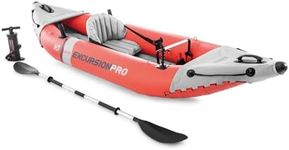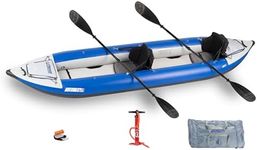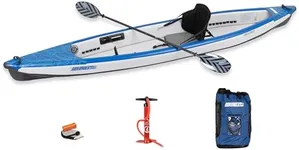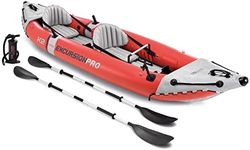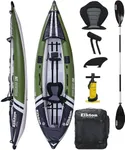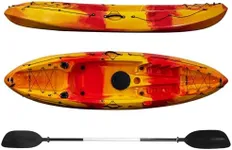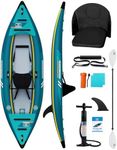Buying Guide for the Best Inflatable Kayak
Choosing the right inflatable kayak can greatly enhance your paddling experience, whether you're a beginner or an experienced kayaker. Inflatable kayaks are versatile, portable, and easy to store, making them a popular choice for many water enthusiasts. To find the best fit for you, it's important to consider several key specifications that will impact your kayaking adventures. Understanding these specs will help you make an informed decision based on your needs and preferences.MaterialThe material of an inflatable kayak determines its durability, weight, and performance. Common materials include PVC, Hypalon, and Nitrylon. PVC is lightweight and affordable but may not be as durable as other materials. Hypalon is more durable and resistant to UV rays and chemicals, making it ideal for long-term use. Nitrylon is eco-friendly and puncture-resistant, suitable for rugged conditions. Choose a material based on where and how often you plan to use the kayak. For casual, occasional use, PVC may suffice, while Hypalon or Nitrylon is better for frequent or rough water conditions.
Weight CapacityWeight capacity refers to the maximum weight the kayak can safely carry, including the paddler and any gear. This is crucial for safety and performance. Kayaks with lower weight capacities (200-300 lbs) are suitable for solo paddlers with minimal gear. Medium capacities (300-500 lbs) can accommodate larger paddlers or additional gear. Higher capacities (500+ lbs) are ideal for tandem kayaking or carrying extensive gear. Assess your weight and the amount of gear you plan to bring to ensure the kayak can handle the load without compromising stability and performance.
Length and WidthThe length and width of an inflatable kayak affect its speed, stability, and maneuverability. Longer kayaks (12-16 feet) are faster and track better, making them suitable for open water and long-distance paddling. Shorter kayaks (8-12 feet) are more maneuverable and easier to handle, ideal for rivers and tight spaces. Wider kayaks offer more stability, which is beneficial for beginners or those paddling in calm waters. Narrower kayaks are faster but less stable, preferred by experienced paddlers. Consider where you'll be kayaking and your skill level when choosing the right dimensions.
Number of ChambersInflatable kayaks have multiple air chambers to enhance safety. If one chamber gets punctured, the others can keep the kayak afloat. Most kayaks have 2-3 main chambers, but some high-end models may have more. More chambers generally mean better safety and stability. For casual use in calm waters, 2-3 chambers are usually sufficient. For more adventurous or rough water conditions, consider a kayak with additional chambers for extra security.
Setup TimeSetup time refers to how long it takes to inflate and prepare the kayak for use. This can range from a few minutes to over 20 minutes, depending on the kayak's design and the pump used. Quick setup times (5-10 minutes) are convenient for spontaneous outings and frequent use. Longer setup times may be acceptable if you prioritize other features like durability or performance. Think about how often you'll be using the kayak and how much time you're willing to spend on setup when making your choice.
Seating ConfigurationSeating configuration determines how many people the kayak can accommodate and how comfortable the seating is. Solo kayaks are designed for one person, while tandem kayaks can carry two or more paddlers. Some kayaks offer adjustable seating, allowing you to switch between solo and tandem configurations. Consider who you'll be kayaking with and whether you prefer the flexibility of adjustable seating. Comfort features like padded seats and backrests can also enhance your paddling experience, especially on longer trips.
